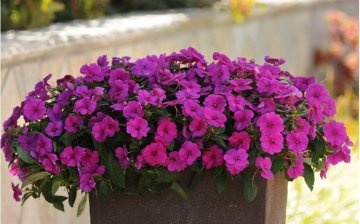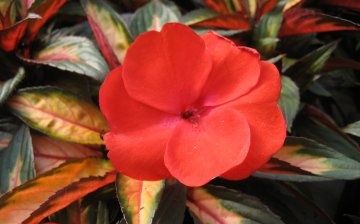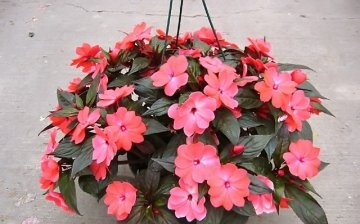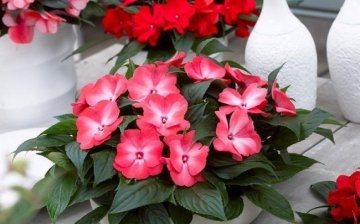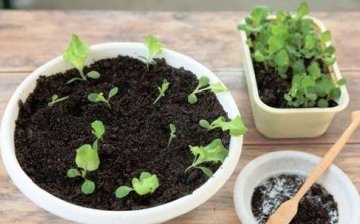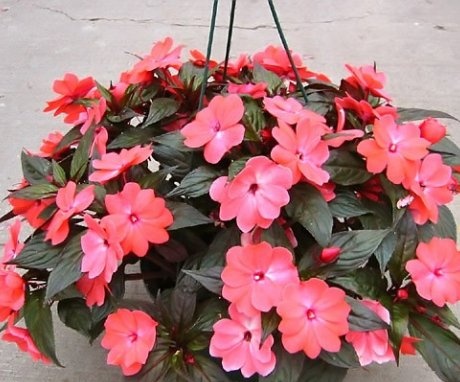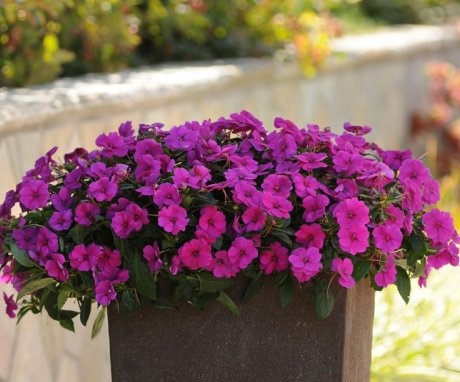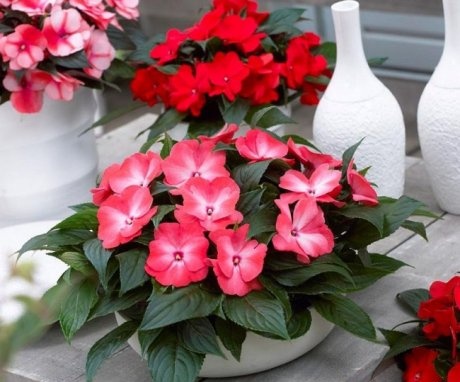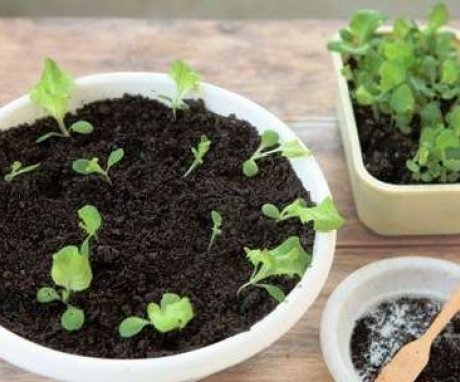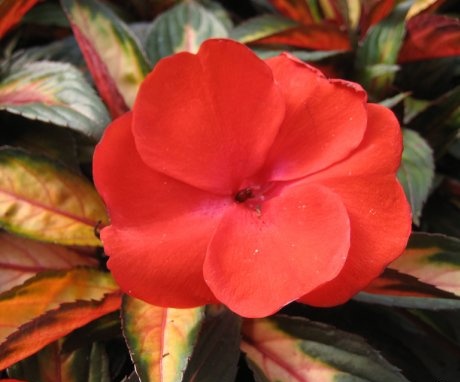Balsam New Guinea - a beautiful and unpretentious perennial
Balsam a fairly common plant in Russia and Europe. It is mainly grown as an indoor flower, but in warm climates it is also planted in open ground. The hybrid variety New Guinea balsam was developed in the early 70s. Currently, it is often used as a decorative one-year-old for planting in open ground, and is also grown, like others, in greenhouses and on window sills.
Content:
- General information about the plant
- Balsam Care Tips
- Pruning and replanting
- Reproduction methods
- Diseases and pests
General information about the plant
Balsam Is a perennial ornamental herb that belongs to the balsamic family. In the people, this flower has acquired the name "touchy". This is due to the fact that the fruits of balsam, containing inside the seeds, when mature, they burst when lightly touched. On the territory of Russia and Europe, the hybrid variety New Guinea balsam is valued for its large and beautiful flowers and compactness of the bush, subject to constant trimming and leaving... The native land of the species is the tropical and subtropical forests of America, Asia and Africa.
Features of the structure:
- In height, the plant, depending on the variety and place of growth, can reach from 30 to 50 cm.
- He has a strong root systemwhich grows and branches well.
- Balsam New Guinea grows in the form of a bush with good branching of the stems, which, unlike other species, have a complete and strong structure.
- Leaves are densely located at the tops. They have an oblong oval shape, sharpened to the ends. The edges are serrate, the veins are pronounced, the petioles are short. The color of the leaves ranges from light green and green to brownish red.
- The flowers are large, can reach 5-7 cm in diameter. The petals are curly, have lateral elongated outgrowths, their color depends on the variety and can be monochromatic or two-color with patterns. The buds are located on the tops of the stems, one or more in the inflorescence.
Period flowering long-term and, depending on the place of growth and climatic conditions, can last for several months. For potted indoor balsam representatives, this period can last up to 10 months.
After pollination, fruits are formed in place of flowers.
They represent an oblong box, the outer part of which is divided by several ribs. After ripening, the fruit opens with the first touch and at the same time throws out the seeds. Thus, the plant reproduces in nature.
Balsam Care Tips
Balsam is one of the easiest plants to care for. It tolerates well both drying out of the soil and waterlogging, but not long-term. At the same time, its decorative effect is lost, the density of foliage period flowering and the number of buds formed. Long periods of waterlogging will likely lead to root rot and plant death. therefore watering should be moderate, but sufficient, since balsam absorbs moisture well.
When grown indoors, maintain a moderate moisture level.
When the air around the flower dries out, the leaves begin to wither and fall off. Therefore, during the heating season, it is recommended to spray the air around the balsam 2-3 times daily or install a humidifier. You can also place the plant pots on a pallet with wet sand or expanded clay, which is watered periodically.
Balsam New Guinea reacts negatively to a sharp temperature drop, hypothermia, even short-term, and drafts. With prolonged cool weather below 12 degrees, the flower dies. Therefore, when landing, it is worth choosing a protected place. Also, the plant should get enough sunlight. But leaves and flowers must be protected from direct sunlight, since burns appear with prolonged exposure. With a lack of light, the balsam stems begin to stretch, which leads to an ugly loose shape and the plant loses its decorative effect.
To maintain the normal functioning of indoor or ground balsam of New Guinea, it is necessary to regularly apply top dressing to the roots:
- During the period of active flowering, gardeners recommend choosing fertilizerscontaining a large amount of potassium and phosphorus. They are brought in together with watering once every 15-20 days.
- To enhance the growth of the bush and increase the green mass, nitrogen-containing feeding.
- After obtaining the necessary growth and shape of the plant, potash and phosphorus fertilizers are applied under the root.
Pruning and replanting
Hybrid varieties such as New Guinea Balsam do not require regular pruning. To enhance branching, at the request of the owner, you can pinch the young tops.
Pruning is necessary if the plant has experienced stress, was in a place with low light, or received excess moisture for a long time. At the same time, its branches stretched out, and the whole bush lost its decorative effect. Such stems are shortened and used for vegetative propagation. When pruning, care must be taken to leave lateral buds for branch growth.
Balsam transplant:
- Process transplants carried out for plants that are grown indoors.
- Balsam grows and develops rapidly, so it is necessary to change the soil every year.
- Transplant is carried out during the dormant period, when all the flowers have fallen off.
- Before you get the rhizomes, you need to water the soil well.
- A pot is pre-prepared, the diameter of which is slightly larger than the old one.
- The soil is selected loose, breathable and fertile. You can buy it from a specialty store or make it yourself. To do this, the sod land is mixed with leafy soil and humus, peat and expanded clay are added.
- The flower is carefully removed together with the earthen clod from the old pot, and the root system is cleared of soil.
- Each part is inspected for availability diseases, rot and dry areas that are removed with a sharp knife.
- Drainage and some prepared soil are poured into the bottom of the new pot.
- Next, you need to place the root system, placing each branch around the perimeter of the bottom of the container.
- The substrate is poured up to the level of the root collar and compacted.
- First watering carried out with a weak solution of manganese for additional disinfection.
Reproduction methods
New Guinea balsam reproduces in two ways, which are widely used in gardening and are not difficult even for a novice florist. The first method is - grafting... For this:
- Young branches are selected and cut with 2-3 internodes.
- Prepare a substrate from equal proportions of peat and calcined river sand.
- Pour it into a wide container and pour it with a weak solution of potassium permanganate for disinfection.
- Before planting, it is recommended to treat the cuttings with a stimulating solution for 2-3 hours.
- Then deepen their lower parts a couple of centimeters in the prepared substrate.
- To improve the effect and the percentage of rooting, it is necessary to create a greenhouse above the seedlings. This can be done by covering each stalk with a cut plastic bottle, or by placing a film over the entire container.
Seedlings need regular care. Ventilate daily and maintain a normal moist soil level. To accelerate the germination of roots, 2-3 days after planting, you can again treat with a stimulating solution.
The second method of reproduction of balsam is done using seed:
- First, it is necessary to prepare a fertile mixture by mixing garden soil with peat and humus in equal proportions.
- Seeds laid out neatly on the soil and sprinkled a little on top.
- Next, moisten everything with a watering can with a spray or spray bottle.
- The container with crops is covered with foil or glass for a greenhouse effect.
- The soil is regularly ventilated and moistened so that the earthy clod does not dry out.
- The first shoots should appear within 1.5-2 weeks.
Diseases and pests
Mostly illness with balsam occur with improper care. All diseases can be seen very clearly on the leaves and their condition:
- The appearance of yellow spots indicates that the plant is being exposed to direct sunlight and is causing burns. This often happens during hot summer months.
- In the winter season, when the heating is turned on, there is a danger of overdrying the air around the plant. This can be seen on dry edges and withered and fallen leaves. During this period, it is necessary to install a humidifier or special trays with water and expanded clay.
- If bright leaves begin to fade, this indicates that the soil does not have the necessary beneficial components. It is worth choosing complex fertilizers to restore nutrients in the plant.
- With excessive watering and waterlogging of the soil, as well as strong damp air, fungal diseases can occur, which lead to rotting of the stems and root system. This disease cannot be cured. The flower is completely removed from the pot, all damaged parts are removed both at the top and at the bottom. All cuts are treated with charcoal, and the flower is treated with special preparations. The prepared plant is placed in a new pot and fresh soil.
Of pests spider mites can often be found on balsam, or aphids... If an infection is detected, the flower is removed from the common room and isolated. For treatment, special drugsthat are processed during the quarantine period balsam and the soil in which it grows.
If necessary, all flowers in the room are also sprayed for prophylaxis.
Balsam New Guinea has found wide application in landscaping the site and is often used by landscape designers. It is unpretentious in care, has a different color of flowers, thanks to which you can create bright and unique compositions. It is also grown as a houseplant and planted in conservatories and greenhouses.
More information can be found in the video:




